Skating in Sonic Space
Sound moves. It moves you – to feel and to dance. Sound itself moves – ‘cos its on wheels – as with roller skaters with sound system back packs. They qualify as sonic street technologies. This is a helpful prompt to broaden our thinking about mobile music machines in the way that it emphasises the importance of mobility. Skaters express this in abundance with their skill, speed and grace. Besides moving sound also territorialises, that is, takes ownership of public and private spaces, even if this only for fleeting moments. Skaters certainly do this too, as you’ll read in what follows about an SST scene very local to the project’s home base at Goldsmiths.
By Thomas Zacharias
Word comes through via the IG and WhatsApp links – meet up BP @ 7. We’re meeting at a spot informally claimed by the Burgess Park Skating Community (BPSC): a square of tarmac wedged between the perennially underfunded adventure playground and the BMX track in Burgess Park. People begin to roll in from either side of the park by around 6.30 – alone, in pairs in or small groups. Deb, who is leading today’s route and two of his friends from South Norwood make a flashy entrance with a spray garnering noisy approval from those already present. Most people know each other and there are warm mutual greetings, banter, chatting… some folks warm up or do stretches while clinging on to the mesh wire fence. Kobi arrives with a speaker strapped to his back.
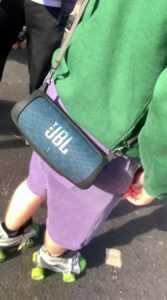
Portable speaker
A quick headcount – there are 34 of us today – someone shouts ‘…OK ready people let’s move..!’ – and we head off north into Portland Street towards the Elephant&Castle. The group stretches out like an accordion and becomes enveloped by music. Jugglerz and Kabaka Pyramid’s ‘Ready’ blares from the speaker at the front end of the group, and travels through it by means of a number of smaller speakers that are chained to the original sound source – and to each other – via Bluetooth. The tempo is gentle, people chat while they move, some bouncing to the beat while propelling themselves forward and gliding effortlessly across pavement, road or cyclepath. Pedestrians stop to watch this odd procession and one throws us a V sign. A cyclist waves hello, the driver in the car waiting for us to pass nods and gives a friendly wave.
At the north end of Waterloo Road we turn east by the IMAX roundabout and along the A32 – there are some nice squares and pedestrian areas just south of the Tate but the decision is to hit the Tate backyard first for a stop and to give people a chance to jam. A route like this is usually either known or reccie’d a couple of days beforehand – the essentials are as much smooth surface as possible, the inclusion of some ‘furniture’ (concrete benches, some steps, tunnels, bridges or ramps) and spots for water breaks and some dancing.
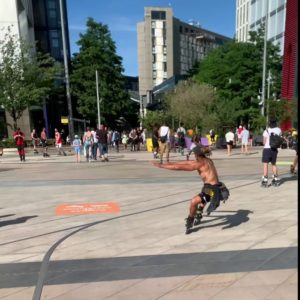
Skating in space
We stop by the plaza near the south entrance to the Tate. The speaker is rested by the foot of the stairs and a gaggle of people begin to dance on their skates, while others use the space to skate backwards at speed in a large circle, some people sit down and chat. Nneeka, sitting next to me, wipes the sweat from her forehead and opens a bag of dried mango… and there comes the first man-who-says-no. Usually clad in hi-viz (or a white dress shirt in more corporate settings) and generically equipped with a lanyard, walkie-talkie, a stabproof vest or any combination of such signifiers of officialdom, these agents of securitocracy are our nemeses. They are the defenders of private space, of pseudo-marble surfaces, entry ways, plazas and normative public behaviour. Their main utterances are ‘no’, ‘not here’, ‘…somewhere else’, ‘PLEASE..!’. Terry and AJ roll over to him and they have a brief discussion. Fortunately, he seems reasonable and appears to secretly enjoy the sudden manifestation of the carnivalesque. We agree to leave in the next ten minutes. He probably won’t be the last one we’ll encounter today… The route then takes us across London Bridge – we’ve covered around five miles already. Quite a few of the skaters transition to backwards and chop-and-shuffle at neck-breaking speed through lines of slow-moving cars. We then head east along London Wall before detouring via the lift and stairs into the labyrinth of the Barbican. This is a brief and exhilarating invasion of its walkways and passages. In recognition of this being a residential area the music is turned off – now the only audible sound is the frrrfrrrfrrrfrrrr of hundreds of polyurethane wheels moving across the tiles. Then we head south to Paternoster Square. ‘Bad Man Forward’ on the speaker, louder this time, and the entire group skates – flashmob like – in a circle around the central column for a few minutes. The skaters cheer and whistle, the high-end of the sound from the speakers echoing back from the buildings around us. Two men-who-say-no emerge from the shadows, arms flailing desperately, unsure about who to address. Being on foot, they operate at a different tempo and before they can identify a suitable interlocutor, someone in the group sounds a whistle… ‘ready, let’s go, ready…’ and the group disappears as quickly as it emerged, down towards St Paul’s and on to the millennium bridge.
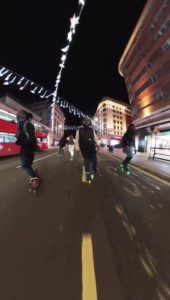
Skaters on Oxford Street
Events like these – spontaneous, convivial processions that are powered by human energy, music and water are exhilarating to partake in. They are but one aspect of London’s burgeoning skate-culture which (re)emerged during the lockdowns imposed during the Covid 19 pandemic. It was noticeable that, since early 2020, inline and quad skating has seen an upsurge in particular areas of London. Parks and skateable public space – particularly in the more densely populated urban areas in Lambeth, Southwark and Tower Hamlets – became increasingly populated by people on eight wheels – some gliding graciously along, switching effortlessly from forwards to backwards, others taking their first penguin steps, precariously balancing their bodies in space. These individuals began coagulating into discernible social groups, united by the thrill of moving through space with wheels attached to their feet. At the point of writing, there are a number of informal skate groups dotted across town, each with between a few dozen to several hundred members. Groups such as WavyOn8, LDN Rollerz, Rolling Distance, RockUpNRoll meet regularly in specific locations across town. Supermarket parking garages, basketball courts, football cages or designated spots in public parks become regular venues in which to practice and socialize. While individual skaters nominally express loyalty to one group or another, the groups intersect and overlap, creating a wide network of roller- and inline-skaters across London.
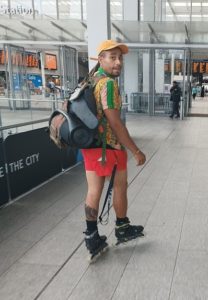
Improvised bass sling
My own involvement with skating both on ice and road goes back a long way into my childhood and adolescence and I have known the people I skate with since before the pandemic and the exponential rise of skate culture it produced. Having said that, skate culture in London was not conceived by the pandemic – it would be more accurate to say that elements of that culture had lain dormant for a decade or two. London’s Caribbean diaspora in particular has had a lively jam skate and rollerhockey scene throughout the 1980s and 1990s which was inspired by – and borrowed from – the US skate scene which emerged out of the civil rights era. The cultural traffic along the axes of the Black Atlantic had a significant impact: London skaters’ cultural repertoire drew on Flipper’s Roller Boogie Palace in LA, Skateland in Halfway Tree in Kingston, Jamaica (which briefly features as a backdrop in the film The Harder They Come), as much as it did from the hockey teams in the US ice hockey league NHL. In the late 1980s, Streatham Ice Rink constituted a gravitational centre for a number of roller-hockey teams that sprung up in South London. A patch of smooth concrete, rollerskates and wooden hockey sticks provided a cheaper alternative to the material and the money required when playing on ice.
The phenomenon of street skating offers a number of interesting themes for analysis and the empirical material is incredibly rich. My passion for skating and my involvement in the Burgess Park Skating Community inspired me to devise a systematic approach of using ethnographic methods in combinations with qualitative interviews – to investigate how street skaters uses of space and music informs their individual and collective subjectivities in a particular moment and political climate.
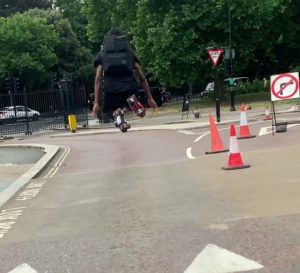
Street furniture
There is a lot to be said about the social and cultural makeup of the group itself. Anchored in the cultural politics – and political cultures – of the Caribbean diaspora, London skate life nonetheless embodies a version of community that might best be described in terms of Gilroy’s (2000) utopian vision of convivial multiculture. For the purposes of this blog, however, I would like to foreground just two elements which stand out: the distinctive use of the commodity form and the group’s engagement with space.
Considering the key writings which have emerged from cultural studies it is possible to make a perfunctory assessment of street skating as a subculture. The recent iteration of skating is linked to a desire for sociality and liberation from governmentally imposed contact restrictions during the lockdowns. Operating in the leisure sphere, skating represents a ‘solution’ to a specific set of circumstances, problems or contradictions (Hebdige 2012), which in this case is a combination of the politics of austerity, the denial of (official) space and the series of Covid lockdowns. Skating also communicates through commodities whose meanings are purposefully distorted or overthrown.
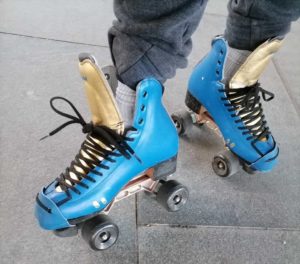
Skate conversion
Most of London’s quad skaters rely almost exclusively on conversions. A conversion is the transformation of an ordinary ice-hockey or figure-skate boot into a rollerskate: technically adept community members operating out of their car-boot, kitchen or bedroom, remove the industrially fitted blade from the boot, drill fixtures into the sole and mount a ‘playmaker’ plate. This plate consists of the frame, trucks and axles on which the skate wheels are installed. Services are rendered for a small fee and are exclusively for members of the community, who are usually expected to organise the plates and parts themselves.This process offers us to think – with Cohen or Hebdige – about the transformation, the deliberate change, of the commodity form.
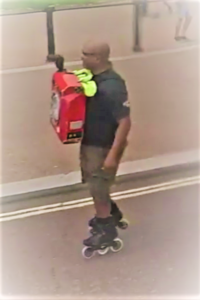
Skater with sound system
While the majority of conversions are the sturdy Bauer or CCM ice-hockey boots (interestingly, neither company ever serially produced quad skates), there are more intriguing manifestations of the conversion. Some skaters have opted to convert highly prized trainers such as Air Force Ones, Air Jordans, Vans, Chucks or Adidas boxing boots into rollerskates. There have even been cases of converted DocMartens (a particularly interesting re-appropriation into the sub-cultural form), or Birkenstocks. Conversions are frequently customised by adding, for example, lights, pendants, knitted or crocheted toe-caps, home made jam-plugs, stickers or spray-paints to their boots. I noticed a particularly hilarious moment of pastiche recently, when a skater rolled up featuring the black underfloor lighting usually found in the cultural realm of sports-car enthusiasts. It is a style that makes use of remodelled, appropriated objects which signifies to the group members themselves. The skate boot, to draw on Hall’s (1976) analysis, reflects and expresses aspects of group life. Skates as cultural objects are homologous with the activities, group structure and collective self-image of the culture. Music features in an equally significant way in any street skate and some group members go to great lengths to fashion portable high-wattage sound systems. This can be in the form of attaching shoulder straps to medium-sized PA or monitor speakers, home-made slings for a JBL boombox, or designing compact portable versions of the speaker systems that street racers install in the boots of their cars. Strapped like a backpack to the chest or shoulders, such systems are crucial in creating the audio landscape – the vibe – for the street skate.
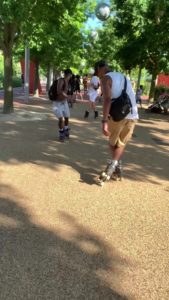
Skating in space
The second aspect that makes London’s (street) skate culture so fascinating is the group’s engagement with space. While skating itself is the individual struggle with space, it also constitutes, collectively, a struggle over space. In a recent interview in the Guardian, Amir, founder of North London group SkateTingz exclaimed that they have for years battled against being moved on from car parks and parks, pointing out that some councils are laying down gravel or lacing spots with oil to stop skaters – an issue he partly puts down to the roots of skating culture being black in the UK. It is against this backdrop that street skating and its spontaneous collective invasion of private or corporate space is such an interesting practice.
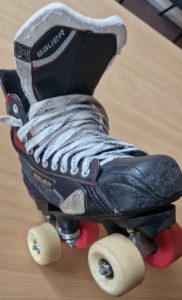
Skate conversion
When thinking about skating and space we can draw on the insights provided by Marxist philosopher Henri Lefebvre, particularly his thoughts on the ‘right to the city’ and the production of space. Lefebvre invites us to think about the production of space as intimately linked to capitalism and its reproduction, suggesting that every mode of social organisation produces an environment that is a consequence of the social relations it possesses (Gottdiener 1993). Lefebvre developed a radical phenomenology of space as a humanistic basis from which to launch a critique of the denial of individual and community’s ‘rights to space’ under the abstract spatialisation embodied in capitalism (Shields, 146). In this context, city centres or financial districts operate, according to Lefebvre in line with a conceptual model which is used to direct and organise practice. These are spaces which classify ‘…in the service of a class.’ (Lefebvre, 1991: 375). The designed and manicured private space of capital in London’s City district, for example, is not the space designed for families on a day out, nor is it designed for a rabble of rollerskaters on a Sunday afternoon trip north of the river. By invading these spaces, London’s street skaters temporarily reclaim and restructure institutionalised space and provide a re-coded version of lived spatialisation. Arguably, such local and punctual détournement – a re-adaptation or hijacking of space – briefly returns hegemonic space to the realm of the community. Space here provides both the reservoir of resources, but also the medium in which strategies are applied. Music adds a sonic component to the symbolic challenge of the dominant order. It literally amplifies the joy experienced collectively in the momentary territorialisation of space and constitutes a symbolic form of resistance in itself. In any street skate, the spaces that we roll on become a terrain of struggle, of engagement and of presence. ‘…OK ready people, let’s move…!’
—
Thomas Zacharias is a lecturer in MCCS. He is interested in cities, the electric bass and polyurethane wheels.
—
Slang:
chop-and-shuffle: a distinctive way of accelerating and weaving while going backwards. A style invented in – and specific to – London
to jam: dancing on rollerskates
spray: a hockeystop-slide from skating backwards
References:
Gilroy, P. 2000. Between Camps: Nations, Culture and the Allure of Race. London: Allen Lane
Gottdiener, M. 1993. “A Marx for Our Time: Henri Lefebvre and the Production of Space.” Sociological Theory 11 (1) p. 129-134
Hall, S., Clarke, J., Jefferson, T. and Roberts, B. (eds). 1976. Resistance Through Rituals. London: Hutchinson.
Hebdige, D. 2012. Subculture: the meaning of style. London: Routledge
Lefebvre, H. 1991. The Production of Space. Oxford: Blackwell
Shields, R. 1991. Lefebvre, Love and Struggle. London: Routledge
Permissions for all pictures granted. Source material from: alphonso_l0ndon; Solange Denker, Ronaldo Duke, Burgess Park Skating Community, Kieran Hall.
All names in the blog have been anonymised.
